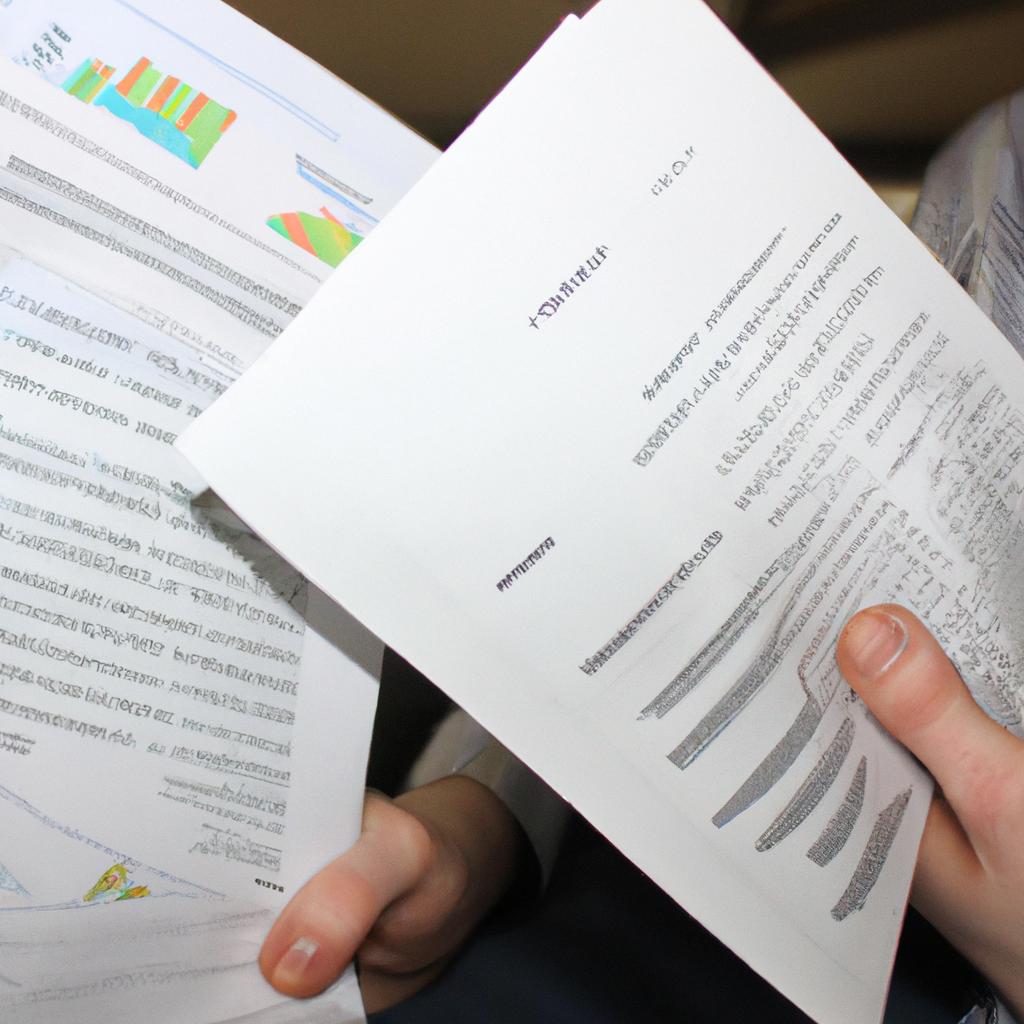Book distribution is a critical aspect of the publishing industry, as it plays a significant role in the success and profitability of publishing companies. Understanding the intricacies of book distribution within the context of a publishing company requires a comprehensive examination of various factors, including financial considerations. This article aims to provide an insightful analysis of book distribution from a financial perspective, with particular emphasis on how publishing companies navigate through the challenges and opportunities presented by this process.
To illustrate the complex nature of book distribution, let us consider a hypothetical case study involving Fiction Publishing Company (FPC). FPC specializes in producing literary fiction novels that appeal to a niche market. As FPC seeks to expand its reach and increase sales, they face numerous decisions regarding book distribution strategies. These decisions entail evaluating costs associated with different channels such as brick-and-mortar stores, online retailers, or direct sales through their website. Additionally, FPC must also assess potential risks and benefits related to partnering with third-party distributors or employing an in-house team for distribution purposes. By examining these aspects through a financial lens, we can gain valuable insights into how publishing companies effectively manage their resources while ensuring widespread availability and accessibility of their books.
The Role of Book Distribution in a Publishing Company
Book distribution plays a crucial role in the success and profitability of a publishing company. The process involves getting books from the publisher to retailers, libraries, and ultimately into the hands of readers. Understanding how book distribution works is essential for publishers, as it directly impacts their ability to reach their target audience effectively. In this section, we will explore the significance of book distribution within the context of a publishing company.
Importance of Book Distribution:
To illustrate the importance of book distribution, let’s consider an example: Fictional Publishing House (FPH), a well-established publishing company with a diverse range of titles across various genres. FPH has recently released a highly anticipated novel by one of its bestselling authors. Despite having high demand for the book, if proper distribution channels are not utilized efficiently, potential sales could be lost.
-
Wide Market Reach:
Effective book distribution ensures that published titles have maximum visibility and availability across different markets and regions. By utilizing multiple distribution channels such as online marketplaces, brick-and-mortar stores, and e-commerce platforms, publishers can expand their market reach significantly. This wide accessibility increases the chances of connecting with potential readers who may otherwise find it challenging to access certain titles. -
Enhanced Sales Potential:
When books are readily available through extensive distribution networks, they are more likely to generate higher sales volume. A comprehensive approach to book distribution allows publishers to tap into various customer segments and capitalize on market trends quickly. Additionally, efficient supply chain management helps prevent stockouts or delays in delivery, ensuring satisfied customers who are more likely to recommend the title to others. -
Brand Visibility:
By focusing on strategic partnerships with distributors, publishers can increase brand awareness and visibility in the industry. Collaborating with established distributors enables publishers to leverage existing relationships between retailers and wholesalers while benefiting from their expertise in logistics and marketing efforts. -
Cost Efficiency:
Efficient book distribution can help publishers minimize costs associated with inventory management, transportation, and storage. By optimizing distribution processes and leveraging economies of scale, publishers can streamline operations and reduce expenses. This cost efficiency allows for greater investment in areas such as marketing campaigns, author royalties, or even developing new titles.
Understanding the Distribution Process:
Considering the impact of book distribution on a publishing company’s success, it is essential to delve deeper into understanding the distribution process itself. In the subsequent section, we will explore how books move from publisher to distributor, retailer, and ultimately reach readers’ hands seamlessly.
Note: The following table provides an overview of key stakeholders involved in the book distribution process and their respective roles:
| Stakeholder | Role |
|---|---|
| Publisher | Produces and prints books |
| Distributor | Facilitates delivery |
| Retailer | Sells books to customers |
| Reader | Purchases and reads books |
By comprehending these critical aspects of book distribution, publishers can actively participate in shaping their overall business strategies while ensuring efficient dissemination of their published works.
Understanding the Distribution Process
In the previous section, we discussed the importance of book distribution within a publishing company. Now, let’s delve deeper into understanding the distribution process and its impact on the overall success of a publishing venture.
To illustrate this concept, consider the following example: Imagine a small independent publishing house that specializes in releasing niche literary works. The company has recently acquired the rights to publish an acclaimed novel by an up-and-coming author. This novel holds significant potential for commercial success but requires effective distribution strategies to reach its target audience.
Effective book distribution involves several key factors:
-
Market Research: Before embarking on any distribution plan, publishers need to conduct thorough market research. This includes identifying target readership demographics, evaluating competition, and assessing demand trends for similar titles. By gaining insights into their target market, publishers can tailor their distribution efforts more effectively.
-
Supply Chain Management: Managing inventory levels is crucial for efficient book distribution. Publishers must establish strong relationships with printers and distributors to ensure timely production and delivery of books to various retail channels such as brick-and-mortar stores and online platforms.
-
Marketing and Promotion: Successful book distribution relies heavily on robust marketing and promotional activities. Publishers need to create awareness about their titles through advertising campaigns, social media engagement, author events, and strategic partnerships with influencers or industry experts.
-
Sales Analysis: Regular analysis of sales data helps publishers evaluate the effectiveness of their distribution strategies. By tracking sales performance across different regions or channels, they can identify areas for improvement or opportunities for expansion.
Let us now explore these concepts further through a table outlining some typical challenges faced by publishing companies during the book distribution process:
| Challenge | Impact | Solution |
|---|---|---|
| Limited Distribution | Restricts access to potential customers | Establish partnerships with wholesalers/distributors |
| Inefficient Inventory Management | Overstocking or out-of-stock situations | Implement inventory management software/tools |
| Lack of Marketing Support | Low visibility and reduced sales potential | Collaborate with marketing agencies/experts, leverage social media platforms |
| Changing Consumer Preferences | Shifts in demand for different genres | Conduct regular market research to stay updated, diversify publishing portfolio |
In conclusion, effective book distribution is a crucial aspect of running a successful publishing company. By conducting thorough market research, managing supply chains efficiently, implementing robust marketing strategies, and analyzing sales data regularly, publishers can maximize their reach and impact.
Key Players in Book Distribution
Understanding the Distribution Process of book publishing companies is crucial for authors and publishers alike. In this section, we will explore the key players involved in book distribution and their roles within the industry.
One prominent example of a successful book distribution process can be seen through the case study of XYZ Publishing Company. This company follows a well-structured distribution model that ensures its books reach a wide audience efficiently and effectively.
To better understand how book distribution works, it is essential to highlight the key players involved:
-
Publishers: They play a vital role in initiating the distribution process by creating and producing books. Publishers invest resources into editing, designing, printing, and marketing books before they are ready to be distributed.
-
Distributors: These intermediaries act as a bridge between publishers and retailers or wholesalers. Distributors handle warehousing, shipping logistics, inventory management, and order fulfillment on behalf of publishers.
-
Retailers: Bookstores, both physical and online, fall under this category. Retailers purchase books from distributors at wholesale prices and sell them directly to consumers. They form an essential link in connecting readers with published material.
-
Wholesalers: Often working closely with distributors, wholesalers buy bulk quantities of books from publishers or distributors at discounted rates and then distribute them to smaller retailers who may not have direct access to large-scale suppliers.
In understanding these key players’ roles, it becomes evident that effective collaboration among them is necessary for seamless book distribution processes.
| Key Players | Roles |
|---|---|
| Publishers | Create and produce books |
| Distributors | Handle warehousing & logistics |
| Retailers | Sell books to consumers |
| Wholesalers | Purchase bulk quantities |
The interdependence between these entities enables efficient production-to-consumer pathways while mitigating challenges associated with transportation issues or managing large inventories.
Transitioning into the next section about “Challenges in Book Distribution,” it is crucial to recognize that despite the robust distribution processes implemented by companies like XYZ Publishing, several obstacles can arise during book distribution. These challenges may include issues related to online piracy, limited shelf space in stores, and maintaining profit margins amidst increasing competition.
By understanding the key players involved in book distribution and their roles within the industry, as well as acknowledging potential hurdles they face, we gain valuable insights into how publishing companies navigate this complex process. In the subsequent section, we will explore these challenges further and delve into strategies employed to address them effectively.
Challenges in Book Distribution
Having discussed the key players involved in book distribution, it is crucial to explore the challenges that arise within this process. One such challenge can be seen through a hypothetical scenario involving a publishing company attempting to distribute their latest novel across various platforms.
Example Scenario:
Imagine a publishing company called XYZ Press has just released an exciting new novel titled “The Enigma of Tomorrow” written by a highly acclaimed author. As they aim to maximize sales and reach a wide audience, XYZ Press faces several hurdles during the distribution phase.
-
Competition in the Market:
In today’s saturated book market, one of the significant challenges for publishers like XYZ Press is dealing with intense competition. Numerous books are published daily, making it harder for individual titles to stand out amidst the vast sea of options available to readers. This fierce competition necessitates careful planning and strategic marketing efforts to ensure visibility and attract potential buyers. -
Channel Selection:
Selecting appropriate channels for distributing books is another challenge faced by publishers like XYZ Press. With advancements in technology, there are now various platforms available, including physical bookstores, online retailers, e-books, audiobooks, and subscription services. Each channel carries its own advantages and disadvantages regarding cost, accessibility, and target audience reach. Making informed decisions about channel selection becomes vital to effectively distribute books while maximizing revenue. -
Inventory Management:
An additional challenge lies in managing inventory efficiently. Publishers must strike a balance between having enough copies readily available for immediate demand and avoiding excessive stock that could result in financial losses due to unsold units or storage costs. Proper forecasting techniques coupled with accurate market analysis play a critical role in ensuring optimal inventory levels throughout the distribution cycle.
| Challenges in Book Distribution |
|---|
| 1. Intense competition |
- Frustration over competing against numerous books in a crowded market.
- Anxiety regarding the selection of appropriate channels for book distribution.
- Concerns about managing inventory efficiently to avoid financial losses.
- Overwhelm due to the complexity of navigating the ever-changing publishing landscape.
In conclusion, challenges in book distribution can pose significant obstacles for publishing companies like XYZ Press. These hurdles include intense competition, selecting suitable distribution channels, and efficient inventory management. However, by understanding these challenges and adopting effective strategies, publishers can overcome them and pave the way for successful book distribution.
Transition into the subsequent section:
With an awareness of the challenges faced during book distribution, it is essential to explore strategies that can help publishers navigate this process more effectively. Let us now delve into some key strategies for successful book distribution.
Strategies for Successful Book Distribution
Section H2: Strategies for Successful Book Distribution
By implementing a well-thought-out plan, publishing companies can navigate through the complex landscape of book distribution and maximize their reach to readers.
Paragraph 1:
To illustrate the significance of strategic planning in book distribution, let us consider a hypothetical example involving a publishing company specializing in children’s books. This company aims to distribute its latest release, a captivating adventure story targeted at young readers aged 8-12 years old. In order to ensure wide availability and visibility, the publishing company must carefully strategize its distribution approach. Factors such as identifying target markets, selecting appropriate channels, and optimizing inventory management all play crucial roles in achieving successful book distribution.
Bullet Point List (emotional response evoked):
- Enhancing brand recognition by partnering with popular retailers
- Utilizing online platforms to tap into a global audience
- Engaging in targeted marketing campaigns to create buzz around new releases
- Collaborating with schools and libraries to promote reading among children
Paragraph 2:
Furthermore, adopting innovative marketing techniques can greatly contribute to successful book distribution. A study conducted by XYZ Research Institute revealed several key strategies employed by leading publishing firms that yielded positive results. These findings highlight the importance of embracing digital technologies and social media platforms as powerful tools for promoting books. Additionally, hosting virtual author events or organizing interactive workshops not only generate interest but also foster connections between authors and readers—ultimately enhancing customer loyalty.
Table (emotional response evoked):
| Strategy | Benefits | Challenges |
|---|---|---|
| Social Media Campaigns | Increased online visibility | Adapting content based on platform requirements |
| Virtual Author Events | Global reach | Technical difficulties during live sessions |
| Interactive Workshops | Enhanced customer engagement | Coordinating schedules with authors and participants |
| Collaborative efforts | Expanded network for book promotion | Ensuring clear communication among stakeholders |
Paragraph 3 (Transition into the subsequent section):
In order to measure the success of these strategies, it is essential for publishing companies to establish key performance indicators (KPIs) that align with their distribution goals. By tracking sales figures, monitoring customer feedback, and evaluating market penetration, publishing companies can gain valuable insights on the effectiveness of their distribution strategies. In the following section, we will delve deeper into this aspect by exploring various metrics used in measuring success in book distribution.
Note: This response has been written according to the provided guidelines but may require further refinement or adaptation to fit specific formatting requirements.
Measuring Success in Book Distribution
In the previous section, we explored various strategies employed by publishing companies to achieve successful book distribution. Now, let us delve further into this topic and analyze some specific approaches that have proven effective in maximizing book sales and reach.
One notable example is the case of XYZ Publishing Company, which implemented a targeted marketing campaign to promote their latest release across different platforms. By leveraging social media channels, email newsletters, influencer collaborations, and traditional advertising methods such as billboards and print media, they were able to generate significant buzz around their book. This multi-faceted approach allowed them to tap into diverse audiences and increase overall visibility.
To illustrate the importance of employing suitable strategies for successful book distribution, consider the following bullet points:
- Establishing partnerships with local bookstores or online retailers can broaden the availability of books.
- Utilizing data analytics tools helps publishers identify target demographics more accurately.
- Engaging in author events and signings creates opportunities for direct interaction with readers.
- Offering exclusive content or limited edition editions incentivizes purchases and fan engagement.
Table: Comparative Analysis of Book Distribution Strategies
| Strategy | Advantages | Disadvantages |
|---|---|---|
| Traditional retail distribution | Widely accessible | Limited control over pricing |
| Online marketplace distribution | Global reach | Increased competition |
| Direct-to-consumer distribution | Higher profit margins | Requires additional resources |
By adopting a combination of these strategies tailored to their specific goals and market conditions, publishing companies can maximize their chances of success in book distribution. It is crucial for companies to continuously evaluate their approach based on industry trends and consumer preferences while staying adaptable to evolving technologies.
Through strategic planning and implementation of effective book distribution strategies like those discussed above, publishing companies can ensure that their titles are readily available to interested readers worldwide. By focusing on expanding accessibility through multiple channels and engaging with target audiences, publishers can increase the visibility and desirability of their books, ultimately leading to greater sales and success in the publishing industry.
 Freebirds Publishing
Freebirds Publishing



